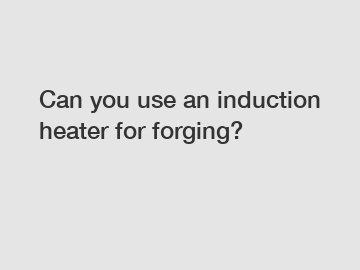Can you use an induction heater for forging?
Can You Use an Induction Heater for Forging?
Forging is a traditional metalworking technique that involves shaping heated metal through the application of force. It requires a heating source capable of reaching high temperatures to allow the metal to become malleable. While gas and coal forges have been the go-to options for centuries, modern techniques and technologies have opened up new possibilities. One such technology is the induction heater. In this article, we will explore whether or not an induction heater can be used for forging and delve into its benefits and limitations.
What is an Induction Heater?

An induction heater is a device that uses electromagnetic induction to heat or melt metal objects. It consists of a coil which generates a rapidly alternating magnetic field when connected to an electrical power source. When a metal object is placed within this field, it induces an electrical current in the metal, causing it to heat up due to electrical resistance. As a result, the metal object reaches high temperatures quickly and efficiently.
Benefits of Using an Induction Heater for Forging.
One significant advantage of using an induction heater for forging is its speed and efficiency. Induction heating allows for quick and precise heating of the metal, saving both time and energy. This is especially valuable in industrial settings where time is of the essence. The ability to heat metal rapidly also reduces oxidation, resulting in a cleaner and more controlled forging process.
Another benefit is the ability to achieve uniform heating. With induction heating, the generated heat is evenly distributed throughout the metal object. This is particularly advantageous when forging intricate designs or working with alloys that require precise temperatures for optimal performance. The even heating ensures consistent results and reduces the risk of deformities.
Additionally, induction heaters offer greater control over the heating process. They can be easily adjusted to monitor and regulate temperature, ensuring that the metal reaches the desired forging temperature and maintaining it throughout the process. The precise control allows for better shaping and minimizes the risk of overheating or underheating, leading to superior quality forgings.
Limitations of Using an Induction Heater for Forging.
Despite its advantages, there are a few limitations when using an induction heater for forging. Firstly, the initial cost of purchasing and setting up an induction heating system can be higher compared to traditional gas or coal forges. However, this cost can be offset by the long-term savings in energy consumption and increased productivity.
Another limitation is the size of the objects that can be forged. Induction heating is most effective for smaller to medium-sized metal objects. Large-scale forging projects may require specialized equipment or alternative heating methods. However, advancements in induction heating technology continue to expand its capabilities, and larger induction furnaces are becoming available.
Conclusion.
In conclusion, while traditional gas and coal forges have been the preferred choice for forging, induction heaters offer several advantages that make them a viable alternative. From their speed and efficiency to the uniform heating and precise control they provide, induction heaters can significantly enhance the forging process. Although there are limitations, particularly in terms of initial cost and size constraints, ongoing developments in technology are addressing these concerns.
If you are considering using an induction heater for forging or have any further questions, please do not hesitate to contact us. Our team of experts is here to provide guidance and support.
If you want to learn more, please visit our website industrial induction heating machine, high frequency annealing machine 40kw manufacturer, induction heating machine manufacturer.


